Workplace Law: Case Study on Sexual Harassment and Employer Liability
VerifiedAdded on 2022/09/16
|6
|1352
|45
Case Study
AI Summary
This case study analyzes a workplace law case involving sexual harassment allegations against Mr. Claudio Vergara by Ms. Jemma Ewin. The analysis examines whether the incidents, occurring at the office, a hotel, and subsequently, fall under the definition of 'workplace' as defined by the Sex Discrimination Act. The study evaluates Mr. Vergara's actions, including sexually explicit comments and physical contact, determining if they constitute sexual harassment. Furthermore, the case assesses the vicarious liability of the employer, Mr. Newton, for failing to address Ms. Ewin's complaints. The conclusion confirms Mr. Vergara's liability for sexual harassment and the employer's vicarious liability for failing to act on the complaints, referencing relevant legal precedents like Ewin v Vergara and Richardson v Oracle Corporation Australia Pty Ltd. The case highlights the importance of understanding workplace harassment and employer responsibilities in maintaining a safe and respectful work environment.
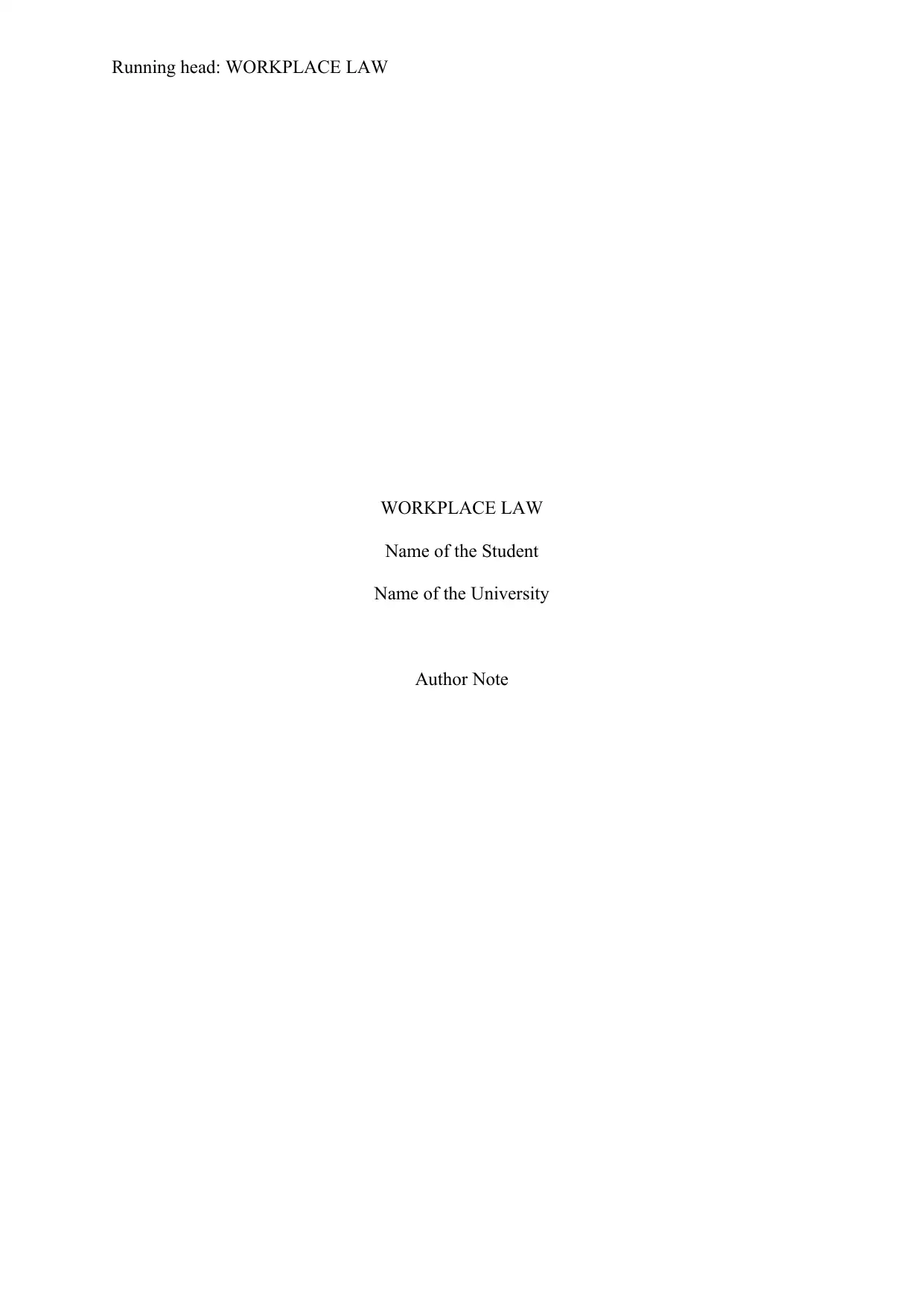
Running head: WORKPLACE LAW
WORKPLACE LAW
Name of the Student
Name of the University
Author Note
WORKPLACE LAW
Name of the Student
Name of the University
Author Note
Paraphrase This Document
Need a fresh take? Get an instant paraphrase of this document with our AI Paraphraser
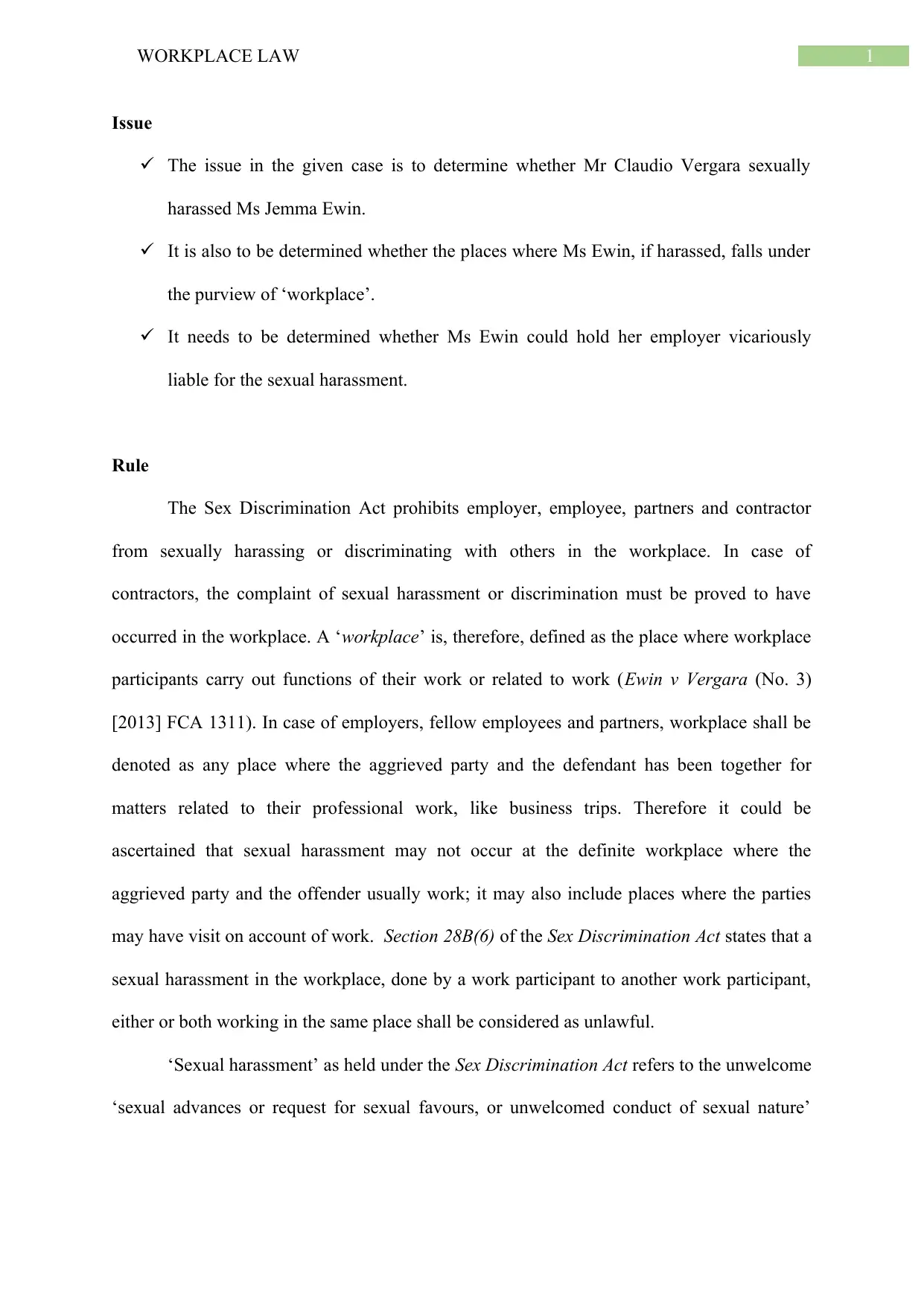
1WORKPLACE LAW
Issue
The issue in the given case is to determine whether Mr Claudio Vergara sexually
harassed Ms Jemma Ewin.
It is also to be determined whether the places where Ms Ewin, if harassed, falls under
the purview of ‘workplace’.
It needs to be determined whether Ms Ewin could hold her employer vicariously
liable for the sexual harassment.
Rule
The Sex Discrimination Act prohibits employer, employee, partners and contractor
from sexually harassing or discriminating with others in the workplace. In case of
contractors, the complaint of sexual harassment or discrimination must be proved to have
occurred in the workplace. A ‘workplace’ is, therefore, defined as the place where workplace
participants carry out functions of their work or related to work (Ewin v Vergara (No. 3)
[2013] FCA 1311). In case of employers, fellow employees and partners, workplace shall be
denoted as any place where the aggrieved party and the defendant has been together for
matters related to their professional work, like business trips. Therefore it could be
ascertained that sexual harassment may not occur at the definite workplace where the
aggrieved party and the offender usually work; it may also include places where the parties
may have visit on account of work. Section 28B(6) of the Sex Discrimination Act states that a
sexual harassment in the workplace, done by a work participant to another work participant,
either or both working in the same place shall be considered as unlawful.
‘Sexual harassment’ as held under the Sex Discrimination Act refers to the unwelcome
‘sexual advances or request for sexual favours, or unwelcomed conduct of sexual nature’
Issue
The issue in the given case is to determine whether Mr Claudio Vergara sexually
harassed Ms Jemma Ewin.
It is also to be determined whether the places where Ms Ewin, if harassed, falls under
the purview of ‘workplace’.
It needs to be determined whether Ms Ewin could hold her employer vicariously
liable for the sexual harassment.
Rule
The Sex Discrimination Act prohibits employer, employee, partners and contractor
from sexually harassing or discriminating with others in the workplace. In case of
contractors, the complaint of sexual harassment or discrimination must be proved to have
occurred in the workplace. A ‘workplace’ is, therefore, defined as the place where workplace
participants carry out functions of their work or related to work (Ewin v Vergara (No. 3)
[2013] FCA 1311). In case of employers, fellow employees and partners, workplace shall be
denoted as any place where the aggrieved party and the defendant has been together for
matters related to their professional work, like business trips. Therefore it could be
ascertained that sexual harassment may not occur at the definite workplace where the
aggrieved party and the offender usually work; it may also include places where the parties
may have visit on account of work. Section 28B(6) of the Sex Discrimination Act states that a
sexual harassment in the workplace, done by a work participant to another work participant,
either or both working in the same place shall be considered as unlawful.
‘Sexual harassment’ as held under the Sex Discrimination Act refers to the unwelcome
‘sexual advances or request for sexual favours, or unwelcomed conduct of sexual nature’
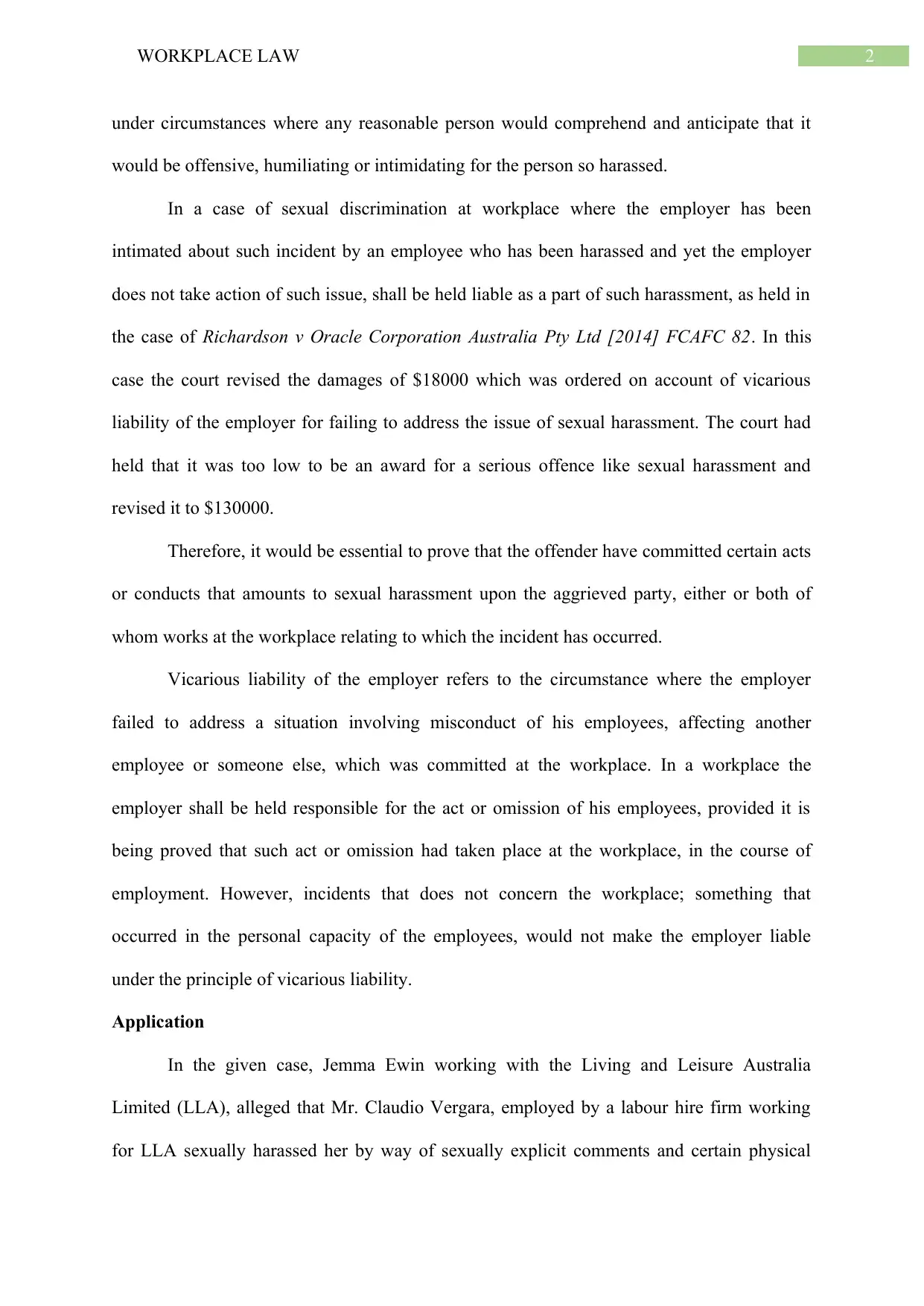
2WORKPLACE LAW
under circumstances where any reasonable person would comprehend and anticipate that it
would be offensive, humiliating or intimidating for the person so harassed.
In a case of sexual discrimination at workplace where the employer has been
intimated about such incident by an employee who has been harassed and yet the employer
does not take action of such issue, shall be held liable as a part of such harassment, as held in
the case of Richardson v Oracle Corporation Australia Pty Ltd [2014] FCAFC 82. In this
case the court revised the damages of $18000 which was ordered on account of vicarious
liability of the employer for failing to address the issue of sexual harassment. The court had
held that it was too low to be an award for a serious offence like sexual harassment and
revised it to $130000.
Therefore, it would be essential to prove that the offender have committed certain acts
or conducts that amounts to sexual harassment upon the aggrieved party, either or both of
whom works at the workplace relating to which the incident has occurred.
Vicarious liability of the employer refers to the circumstance where the employer
failed to address a situation involving misconduct of his employees, affecting another
employee or someone else, which was committed at the workplace. In a workplace the
employer shall be held responsible for the act or omission of his employees, provided it is
being proved that such act or omission had taken place at the workplace, in the course of
employment. However, incidents that does not concern the workplace; something that
occurred in the personal capacity of the employees, would not make the employer liable
under the principle of vicarious liability.
Application
In the given case, Jemma Ewin working with the Living and Leisure Australia
Limited (LLA), alleged that Mr. Claudio Vergara, employed by a labour hire firm working
for LLA sexually harassed her by way of sexually explicit comments and certain physical
under circumstances where any reasonable person would comprehend and anticipate that it
would be offensive, humiliating or intimidating for the person so harassed.
In a case of sexual discrimination at workplace where the employer has been
intimated about such incident by an employee who has been harassed and yet the employer
does not take action of such issue, shall be held liable as a part of such harassment, as held in
the case of Richardson v Oracle Corporation Australia Pty Ltd [2014] FCAFC 82. In this
case the court revised the damages of $18000 which was ordered on account of vicarious
liability of the employer for failing to address the issue of sexual harassment. The court had
held that it was too low to be an award for a serious offence like sexual harassment and
revised it to $130000.
Therefore, it would be essential to prove that the offender have committed certain acts
or conducts that amounts to sexual harassment upon the aggrieved party, either or both of
whom works at the workplace relating to which the incident has occurred.
Vicarious liability of the employer refers to the circumstance where the employer
failed to address a situation involving misconduct of his employees, affecting another
employee or someone else, which was committed at the workplace. In a workplace the
employer shall be held responsible for the act or omission of his employees, provided it is
being proved that such act or omission had taken place at the workplace, in the course of
employment. However, incidents that does not concern the workplace; something that
occurred in the personal capacity of the employees, would not make the employer liable
under the principle of vicarious liability.
Application
In the given case, Jemma Ewin working with the Living and Leisure Australia
Limited (LLA), alleged that Mr. Claudio Vergara, employed by a labour hire firm working
for LLA sexually harassed her by way of sexually explicit comments and certain physical
⊘ This is a preview!⊘
Do you want full access?
Subscribe today to unlock all pages.

Trusted by 1+ million students worldwide
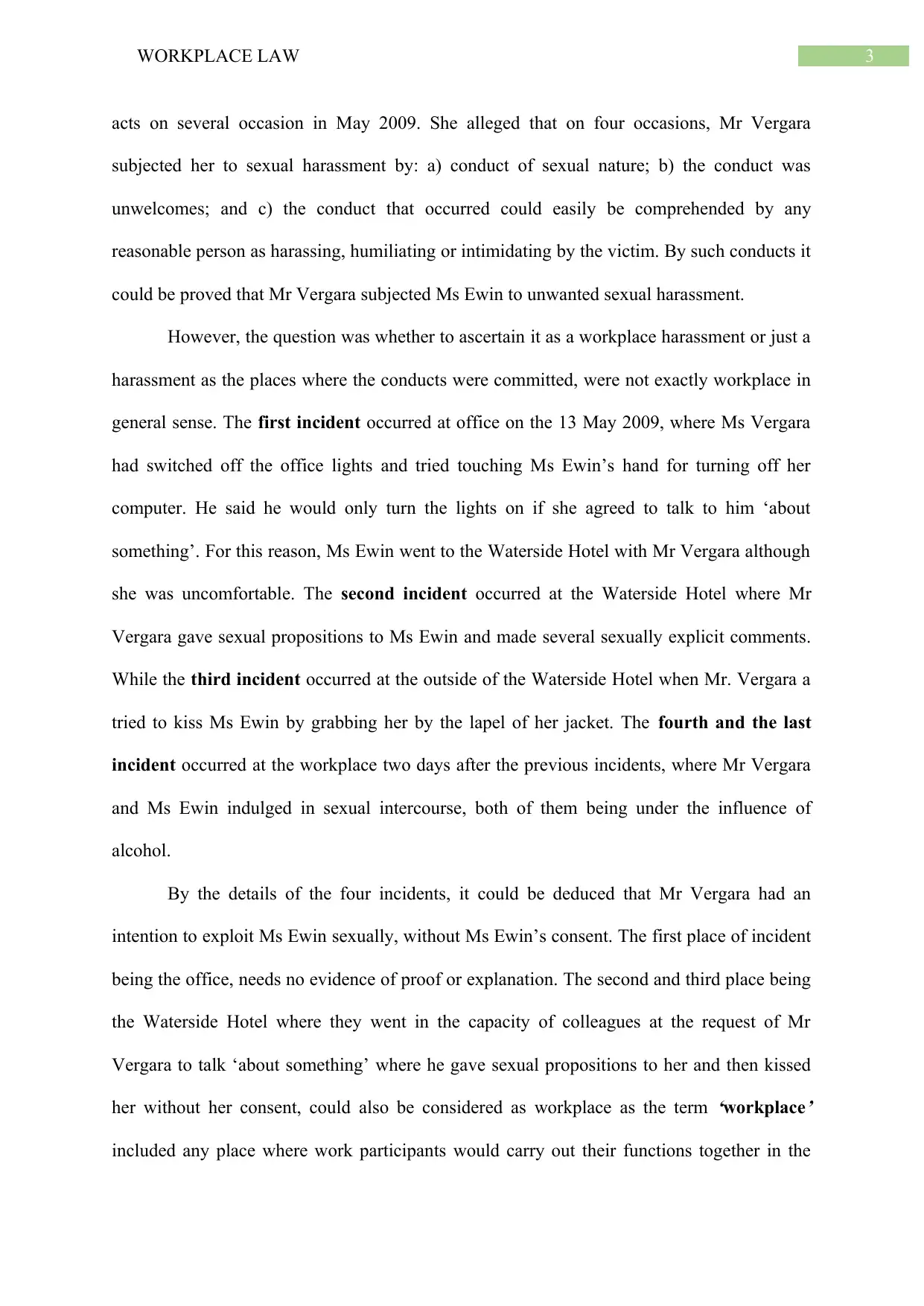
3WORKPLACE LAW
acts on several occasion in May 2009. She alleged that on four occasions, Mr Vergara
subjected her to sexual harassment by: a) conduct of sexual nature; b) the conduct was
unwelcomes; and c) the conduct that occurred could easily be comprehended by any
reasonable person as harassing, humiliating or intimidating by the victim. By such conducts it
could be proved that Mr Vergara subjected Ms Ewin to unwanted sexual harassment.
However, the question was whether to ascertain it as a workplace harassment or just a
harassment as the places where the conducts were committed, were not exactly workplace in
general sense. The first incident occurred at office on the 13 May 2009, where Ms Vergara
had switched off the office lights and tried touching Ms Ewin’s hand for turning off her
computer. He said he would only turn the lights on if she agreed to talk to him ‘about
something’. For this reason, Ms Ewin went to the Waterside Hotel with Mr Vergara although
she was uncomfortable. The second incident occurred at the Waterside Hotel where Mr
Vergara gave sexual propositions to Ms Ewin and made several sexually explicit comments.
While the third incident occurred at the outside of the Waterside Hotel when Mr. Vergara a
tried to kiss Ms Ewin by grabbing her by the lapel of her jacket. The fourth and the last
incident occurred at the workplace two days after the previous incidents, where Mr Vergara
and Ms Ewin indulged in sexual intercourse, both of them being under the influence of
alcohol.
By the details of the four incidents, it could be deduced that Mr Vergara had an
intention to exploit Ms Ewin sexually, without Ms Ewin’s consent. The first place of incident
being the office, needs no evidence of proof or explanation. The second and third place being
the Waterside Hotel where they went in the capacity of colleagues at the request of Mr
Vergara to talk ‘about something’ where he gave sexual propositions to her and then kissed
her without her consent, could also be considered as workplace as the term
‘workplace
’
included any place where work participants would carry out their functions together in the
acts on several occasion in May 2009. She alleged that on four occasions, Mr Vergara
subjected her to sexual harassment by: a) conduct of sexual nature; b) the conduct was
unwelcomes; and c) the conduct that occurred could easily be comprehended by any
reasonable person as harassing, humiliating or intimidating by the victim. By such conducts it
could be proved that Mr Vergara subjected Ms Ewin to unwanted sexual harassment.
However, the question was whether to ascertain it as a workplace harassment or just a
harassment as the places where the conducts were committed, were not exactly workplace in
general sense. The first incident occurred at office on the 13 May 2009, where Ms Vergara
had switched off the office lights and tried touching Ms Ewin’s hand for turning off her
computer. He said he would only turn the lights on if she agreed to talk to him ‘about
something’. For this reason, Ms Ewin went to the Waterside Hotel with Mr Vergara although
she was uncomfortable. The second incident occurred at the Waterside Hotel where Mr
Vergara gave sexual propositions to Ms Ewin and made several sexually explicit comments.
While the third incident occurred at the outside of the Waterside Hotel when Mr. Vergara a
tried to kiss Ms Ewin by grabbing her by the lapel of her jacket. The fourth and the last
incident occurred at the workplace two days after the previous incidents, where Mr Vergara
and Ms Ewin indulged in sexual intercourse, both of them being under the influence of
alcohol.
By the details of the four incidents, it could be deduced that Mr Vergara had an
intention to exploit Ms Ewin sexually, without Ms Ewin’s consent. The first place of incident
being the office, needs no evidence of proof or explanation. The second and third place being
the Waterside Hotel where they went in the capacity of colleagues at the request of Mr
Vergara to talk ‘about something’ where he gave sexual propositions to her and then kissed
her without her consent, could also be considered as workplace as the term
‘workplace
’
included any place where work participants would carry out their functions together in the
Paraphrase This Document
Need a fresh take? Get an instant paraphrase of this document with our AI Paraphraser
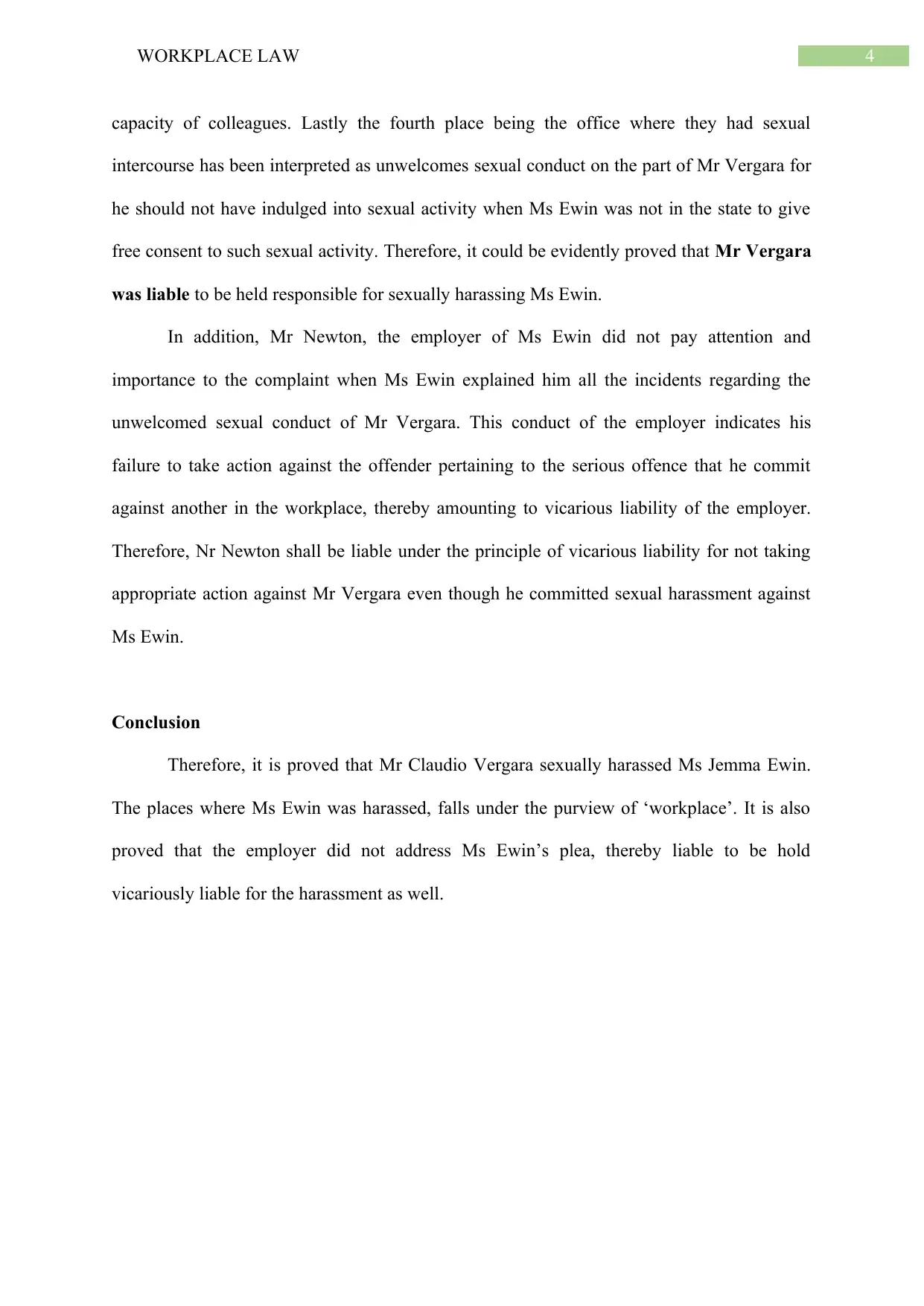
4WORKPLACE LAW
capacity of colleagues. Lastly the fourth place being the office where they had sexual
intercourse has been interpreted as unwelcomes sexual conduct on the part of Mr Vergara for
he should not have indulged into sexual activity when Ms Ewin was not in the state to give
free consent to such sexual activity. Therefore, it could be evidently proved that Mr Vergara
was liable to be held responsible for sexually harassing Ms Ewin.
In addition, Mr Newton, the employer of Ms Ewin did not pay attention and
importance to the complaint when Ms Ewin explained him all the incidents regarding the
unwelcomed sexual conduct of Mr Vergara. This conduct of the employer indicates his
failure to take action against the offender pertaining to the serious offence that he commit
against another in the workplace, thereby amounting to vicarious liability of the employer.
Therefore, Nr Newton shall be liable under the principle of vicarious liability for not taking
appropriate action against Mr Vergara even though he committed sexual harassment against
Ms Ewin.
Conclusion
Therefore, it is proved that Mr Claudio Vergara sexually harassed Ms Jemma Ewin.
The places where Ms Ewin was harassed, falls under the purview of ‘workplace’. It is also
proved that the employer did not address Ms Ewin’s plea, thereby liable to be hold
vicariously liable for the harassment as well.
capacity of colleagues. Lastly the fourth place being the office where they had sexual
intercourse has been interpreted as unwelcomes sexual conduct on the part of Mr Vergara for
he should not have indulged into sexual activity when Ms Ewin was not in the state to give
free consent to such sexual activity. Therefore, it could be evidently proved that Mr Vergara
was liable to be held responsible for sexually harassing Ms Ewin.
In addition, Mr Newton, the employer of Ms Ewin did not pay attention and
importance to the complaint when Ms Ewin explained him all the incidents regarding the
unwelcomed sexual conduct of Mr Vergara. This conduct of the employer indicates his
failure to take action against the offender pertaining to the serious offence that he commit
against another in the workplace, thereby amounting to vicarious liability of the employer.
Therefore, Nr Newton shall be liable under the principle of vicarious liability for not taking
appropriate action against Mr Vergara even though he committed sexual harassment against
Ms Ewin.
Conclusion
Therefore, it is proved that Mr Claudio Vergara sexually harassed Ms Jemma Ewin.
The places where Ms Ewin was harassed, falls under the purview of ‘workplace’. It is also
proved that the employer did not address Ms Ewin’s plea, thereby liable to be hold
vicariously liable for the harassment as well.
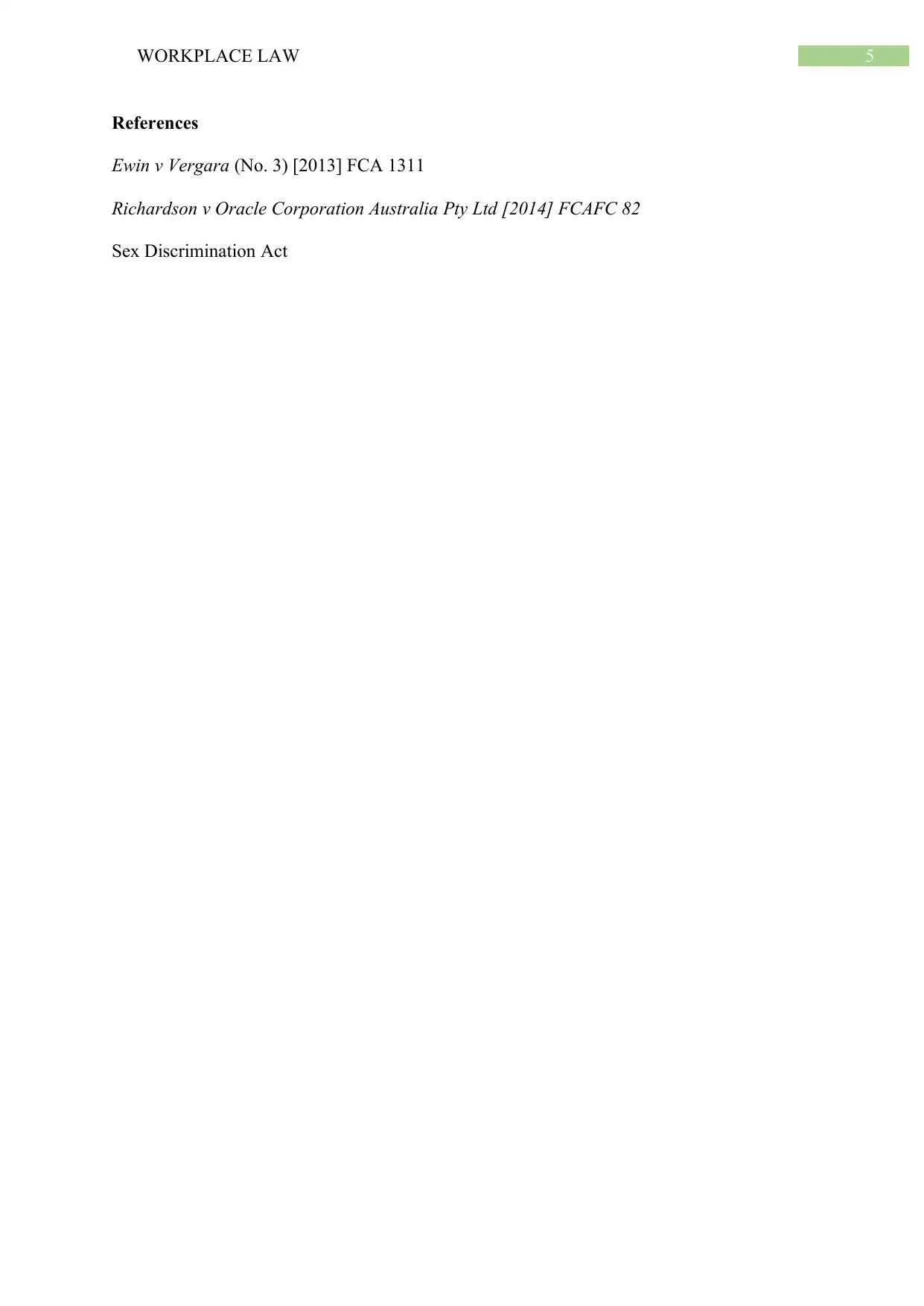
5WORKPLACE LAW
References
Ewin v Vergara (No. 3) [2013] FCA 1311
Richardson v Oracle Corporation Australia Pty Ltd [2014] FCAFC 82
Sex Discrimination Act
References
Ewin v Vergara (No. 3) [2013] FCA 1311
Richardson v Oracle Corporation Australia Pty Ltd [2014] FCAFC 82
Sex Discrimination Act
⊘ This is a preview!⊘
Do you want full access?
Subscribe today to unlock all pages.

Trusted by 1+ million students worldwide
1 out of 6
Related Documents
Your All-in-One AI-Powered Toolkit for Academic Success.
+13062052269
info@desklib.com
Available 24*7 on WhatsApp / Email
![[object Object]](/_next/static/media/star-bottom.7253800d.svg)
Unlock your academic potential
Copyright © 2020–2025 A2Z Services. All Rights Reserved. Developed and managed by ZUCOL.





